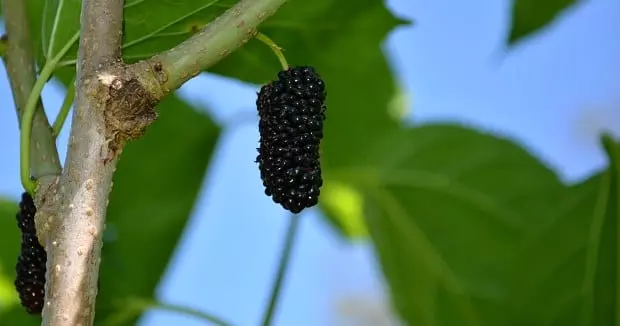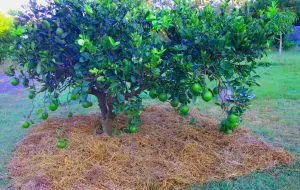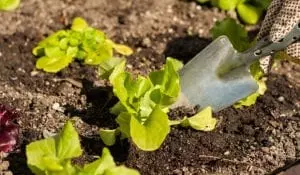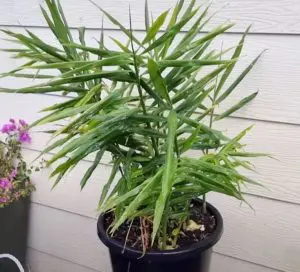If I were to pick one tree which has stayed with me memorably since my childhood it would be the mulberry. When I was a boy there used to be a massive mulberry tree growing in a vacant lot adjacent to the laneway I walked through to get to primary school. Every spring I’d grab a few quick bites before school and practically eat my fill after school.
Once I was too impatient to wait for the mulberry’s to fully ripen and I ended up eating too many semi-ripe fruits which swelled inside my stomach and gave me such severe tummy ache that I threw up painting the toilet bowl with the most vibrant pink you’ll ever see! I learnt big time from that mistake but it never put me off from wanting to eat them again (just the ripe ones).

When we first moved to our acreage 8 years ago, I was pleased to find we had one established mulberry tree; unfortunately, it turned out to be the kind with a very tiny fruit and a bushy growth habit more like a Black Berry and it was hardly worth keeping. Before I ripped it out (to replace it with a better variety) I had the opportunity to introduce my eldest son (James – toddler at the time) to mulberry eating and it didn’t take him long to get the gist. Whenever, we ventured into the backyard James would gravitate towards the mulberry tree.
Today, James is 10 and he and his brother Luke (7) almost never fail to inspect our two mulberry trees for ripe fruit daily often retuning with purple stained fingers and lips. Our trees are still rather young but they are producing well and this will only improve each year from now as the trees mature.
Growing a mulberry tree (or two)
The wonderful mulberry is a fast growing medium sized deciduous tree which produces dark purple/black elongated fruit (berries) up to 4 cms long. After a dormant period standing naked through winter the tree “springs into action” in early spring to quickly cover itself with large lime green leaves and the prickly beginnings of fruit which form and ripen independently over several months.
Fruit and tree size – Firstly, when it comes to choosing a mulberry tree for your garden ensure it is the type which produces the larger fruit (on average) a variety like the English mulberry is a good start. Some fruit on a larger producer will still be small but what you definitely do not want is a mulberry type with all small fruit because they tend to be hardly worth eating, and more so, the small fruit quickly dry and deteriorate when ripe.
Fruit size is about the only contentious part of mulberry growing because the rest is easy. Mulberries grow into a large spreading tree usually with a single stem (unless it wasn’t cultivated property or if it was cut back severely). The tree doesn’t get overly tall (maybe about 5 metres) but I’ve seen them double garage wide!
Soil – Soil type or growing medium is not a problem either and it will grow in just about anything as long as it doesn’t sit too long in waterlogged conditions. I had to move one of my mulberry trees due to accidentally planting it in a bog hole (which wasn’t evident through a drought) the tree was struggling on and wasn’t dying but it wasn’t thriving either and moving it helped the tree dramatically – I wrote about it here.
Site – Mulberry trees grow fine in part shade but full sun is the best position. They can be great as a feature plant in the backyard or near a picnic area. Due to the spreading nature of the tree, I wouldn’t plant one too near the house especially if the fruit was not expected to be fully harvested because it could get messy.

Mulberry tree in our picnic area (image above)
Care and fertiliser – I wouldn’t prune a mulberry deliberately each season because I think they are best left to grow as natural as possible. However, there will be times when the odd branch will need to be pruned or the tree kept smaller due to size constraints in a backyard and mulberries cope fine with pruning. If children are likely benefactors it’s nice to leave the tree drape some branches close to the ground so the kids can get some easy pickings.
Mulberries don’t seem to need much fertiliser and I’ve seen many neglected trees which have never had a fist of NPK but they still look healthy and produce lots of fruit. Nevertheless, I do fertilise our trees with a little citrus or fruit tree fertiliser once a year as the growing season begins.
Pests and disease – I haven’t had much experience when it comes to seeing pests or disease on mulberry trees, thankfully. Scale can sometimes invade the plant and a little organic oil spray fixes that or rubbing off with fingers. Fruit fly can occasionally sting the berries in susceptible areas according to my Aunt Nanette who has seen them in her mulberries but I live in a fruit fly area and ours don’t seem to get stung.
Other facts
Mulberries are one of the best "berries" to grow. Unlike other berries, it doesn't have thorns or spikes, it isn't invasive, it's not a cane or plant which needs to be cut back each season, they fruit profusely, they’re easy to care for, and they look great in the garden.
Mulberry trees can be grown from cuttings so if you see a good tree it might be worth grabbing a few small cuttings and potting them up.
You can get white coloured mulberries (the tree produces a white fruit instead of the dark purple or black).
You can get dwarf mulberries for pots or smaller yards.
Nutritionally, mulberries are high in fibre and a very good source of vitamin C, vitamin K, and Iron. They are also full of antioxidants and whilst I can’t guarantee it, eating mulberries should make you live longer…

An unripe mulberry (image above)
Mulberries make an awesome jam – but you already knew that.
The mulberry leaf is a food source for the silk worm and a great project for school kids is to keep some silk worms/caterpillars at home feeding them the mulberry leaves until they spin their silk cocoons to change into silk moths. Teaches children the cycle of life and also where natural silk for clothing etc comes from.
The mulberry tree is the base for one the most famous children’s nursery rhymes of all time – Here we go round the mulberry tree … or bush.
Overall, the mulberry tree is a very hardy plant and so easy to grow in such a diverse climate range that growing at least one is a must for any fruit and garden lover!
Conclusion
Considering just a few simple points from above the mulberry is a true wonder of the world as it’s not only a healthy snack and a hugely important commercial asset but it’s also the base for childhood memories.
So if you didn’t know a mulberry tree when you were growing up then it’s time to re-live your childhood, grow a mulberry tree and see what you missed out on – it’s never too late for a mulberry and it’s never too late to merrily go round one…
We like seeing comments and answering questions so you can do both below or on our forum Self Sufficient Culture it would be nice of you to join our online community.
Mark Valencia – Editor SSM
Look, and see the Earth through her eyes…













